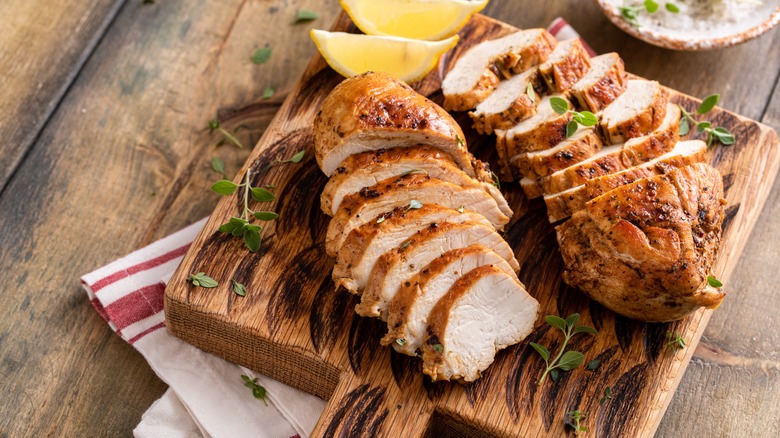How To Cook Chicken Breast In A Pan Depends On Its Thickness
A pan-seared chicken breast is always delicious and highly versatile. You can put it on salads, in grain bowls, on sandwiches, and more. It also comes together pretty quickly, although the results won't always be the same. If you notice that some chicken breasts brown perfectly while others tend to be undercooked, you'll need to adjust how you cook your chicken breast based on its thickness.
Pan-seared chicken should always have a golden brown exterior that's slightly crisp, with an inside that's juicy, tender, and — most importantly — fully cooked. The ideal internal temperature for perfectly cooked chicken is 165 degrees Fahrenheit; any less, and you risk getting a food borne illness. If you want to cook the meat quickly and ensure that it's done, having a chicken breast that's ¼ to ½ inch thick works best. Even if the outside starts to brown a little faster, the meat within will follow suit, reaching the proper temperature within a matter of minutes.
With a thicker cut, it'll take a longer time for the heat to reach the center. If you cook it at a higher heat (like you could with a thinner cut), the outside will get done while the inside remains raw. Instead, go low and slow. Turn the temperature down to a medium-low heat and give the breast time to cook, flipping it after around eight minutes. Once both sides are browned, check the meat with a food thermometer to ensure that it's cooked.
How to tell if chicken is done without a meat thermometer
Having a meat thermometer is the best way to prevent your chicken from being raw in the middle. If you don't have one on hand, however, there are some other methods to check the doneness of your chicken breast. Poking the center of the chicken breast with a toothpick is an old-school trick to ensure it's fully cooked. If the toothpick comes back dry or with clear juice, the chicken is most likely cooked through. If it's pink, you'll need to put the chicken back on the pan so it can cook a little while longer.
While not entirely foolproof, touching the chicken before taking it out of the pan could key you in to its doneness. Chicken that springs back when poked or feels soft isn't done cooking. If the chicken breast is firm, though, it's probably ready to be taken off the stove. If you want to decrease the risk of eating undercooked chicken, simply go with a thinner slice. There's a slicing method for perfectly even chicken cutlets that will turn a thick piece of chicken breast into a thin one. Cut the breast width-wise and pound it with a meat mallet to even out the slices.

